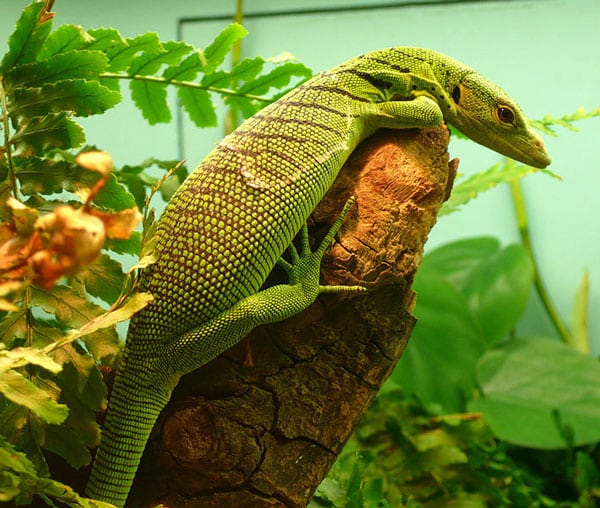When most people think of monitor lizards, they envision large and powerful reptiles, similar to the Komodo dragon (Varanus komodoensis). Vivid coloration is rarely associated with varanids, as most well-known species like V. salvator and V. exanthematicus exhibit rather subdued hues. In contrast, members of the tree monitor group (the Varanus prasinus complex) display some of the most striking coloration within the varanid family, with the green tree monitor (V. prasinus) being the most renowned and extensively studied species.
Natural History The green tree monitor, also known as the emerald tree monitor, is a medium-sized varanid belonging to the Indo-Australian subgenus Euprepiosaurus. This subgenus includes both mangrove monitors and tree monitor species groups. As its name implies, the green tree monitor possesses several specialized adaptations that support an arboreal lifestyle.Varanus prasinus is endemic to New Guinea and several adjacent islands, as well as a few islands within the Torres Strait, a body of water separating Papua New Guinea and northern Queensland, Australia. The green tree monitor is reported to occur in various lowland environments throughout its range, including tropical evergreen forests, palm swamps, and cocoa plantations.
Tim Vickers/Wikipedia One of the best ways to prepare for keeping a potentially difficult monitor lizard such as V. prasinus is to begin with a less-sensitive monitor species, such as the ridge-tailed monitor (V. acanthurus). From the Wild to Captivity Green tree monitors are among the most strikingly colored monitor species, exhibiting shades ranging from green to turquoise, accentuated by dark, transverse dorsal banding.Their impressive size and brilliant coloration have made them one of the most coveted monitor lizards in captivity today.
It is crucial to understand that tree monitors are among the most fragile and sensitive monitor species in captivity. They do not tolerate keeper errors and respond poorly to stress or handling. Handling should be avoided at all costs. It cannot be overemphasized that V. prasinus is not suitable for beginners and can be exceptionally challenging to keep healthy in captivity. Unfortunately, their sensitive nature has seldom been addressed in historical herpetocultural literature, leading to numerous failed attempts at keeping them. The most common reason for failure is impulse purchases by unprepared hobbyists who lack knowledge about the species or its captive care requirements.One of the best ways to prepare for keeping a potentially challenging monitor lizard species, such as V. prasinus, is to begin with a less-sensitive monitor like the ridge-tailed monitor (V. acanthurus). The experience gained from keeping a more tolerant species teaches the keeper how to interpret varanid behaviors and identify potential issues before they become critical.
The information provided in this article serves as a general guideline covering key aspects of successfully keeping green tree monitors in captivity. Many hobbyists tend to rely solely on caresheets to model their husbandry for a specific species. Following such rigid instructions often hinders the ability to learn from individual captives.Without ever manipulating or testing any of the conditions offered to the captives, it is nearly impossible to gain an understanding of what is best for the animals. The best caresheet one can follow when keeping reptiles is observation of the behaviors and actions of the animals themselves and how well they respond to different situations and conditions. Proper husbandry for any reptile requires constant adjustment and manipulation of the conditions being offered, in order to keep up with the changing needs of one’s captives as they grow, mature and age.
Hydration and Acclimation Unfortunately, due to a lack of reproductive success in captivity, virtually all of the green tree monitors encountered in captivity are wild caught. Wild-caught tree monitors are often stressed and arrive in terrible physical condition.Dehydration is the most common ailment observed in newly imported V. prasinus and represents the leading cause of mortality in this species.
Proper hydration is the most critical factor for successfully maintaining green tree monitors and should be the primary focus upon acquisition. Originating from high-humidity environments, Varanus prasinus generally cannot tolerate humidity levels below 70%. While housing a dehydrated tree monitor in an enclosure with adequate humidity can prevent further dehydration, rehydration occurs only through regular water intake. In most cases, the most effective method to encourage drinking is through daily frequent misting, as tree monitors typically avidly consume water droplets from their surroundings. It is generally advisable to rehydrate an individual before attempting feeding.Upon arrival, each monitor should be quarantined separately to allow close observation during acclimation. Keep monitors isolated until they are fully rehydrated and their feeding behaviors, patterns, and preferences are thoroughly understood. Introducing a pair of tree monitors directly into a shared enclosure upon receipt almost always leads to failure, with females typically declining first. Without a solid understanding of their behaviors, assessing an individual’s health and condition may prove difficult until it is too late. Ensure sufficient time is taken to understand each monitor before introductions. Patience is critical, as rushing this process results in complications.
Housing There are numerous acceptable methods for housing green tree monitors.Successful keeping and breeding have occurred in many different setups. Custom enclosures specifically designed and built for tree monitors are a necessity. Some of the most important enclosure elements include the total amount of usable surface area for climbing, the ability to retain high humidity levels, and to hold a temperature gradient.
Green tree monitors are highly active lizards and spend a considerable amount of time in trees. When designing an enclosure, it is important to place the emphasis of its design on height. These monitors use every square inch of space provided to them; space management is extremely important. The easiest way of maximizing usable surface area is to render the walls climbable by affixing a climbable material, such as cork tiles, cork flats, garden lattice, or vinyl hardware cloth.By doing so, the total amount of usable surface area within the enclosure can be increased at least threefold. Provided that interior space is maximized, a pair of V. prasinus can live successfully in an enclosure measuring 4 feet wide by 6 feet tall by 2 feet deep, although larger is usually better. It is also a good idea to keep a separate enclosure on hand in the event that animals need to be separated.
Humidity retention is another extremely important element. When dealing with tropical species that dehydrate easily, ventilation can become a serious problem. The use of screening or large vents only encourages the loss of humidity from within the enclosure. Sufficient air exchange occurs within the enclosure through daily maintenance and feedings. There is no need for air vents within the enclosure.It is crucial to maintain relative humidity levels above 70 percent to prevent dehydration.
Caging Elements: Leaf litter serves as an excellent substrate due to its moisture retention properties and support of natural behaviors like foraging, sifting, and digging. Given the highly nervous disposition of V. prasinus, providing multiple retreat areas throughout the enclosure is essential for security. Hides can be made from various materials, but variation in environmental conditions within each shelter is critical. Some hides should offer warmer temperatures, others higher humidity, and some should be darker. This variation allows monitors to meet diverse physiological needs while feeling safe and secure.It is also important to understand that if a hide is too spacious, it does not provide the necessary safety and security. A monitor must be able to tightly wedge itself into the space and feel its surroundings pressed against its body in order to feel secure.
Branches are an integral element of the functionality of an enclosure. Keepers often use climbing branches that are too narrow for their intended use. Green tree monitors have an elongated body, with long limbs for utilizing large, thick trunks and tree limbs, not skinny branches and twigs. Branches that measure greater than 4 inches in diameter are better suited for the body type of V. prasinus. As with all monitors, green tree monitors require access to a fairly broad temperature gradient in order to maintain a healthy metabolism. Access to temperatures ranging from a basking site of 120 to 130 degrees Fahrenheit, down to cooler areas in the low 80s allow the monitor to properly regulate its metabolism.Basking temperatures can be achieved through various heating devices. Halogen outdoor floodlamps provide superior benefits compared to conventional heating elements. A 12/12-hour photoperiod is ideal for V. prasinus, though supplemental nighttime heating may be necessary to maintain ambient temperatures in the low 80s (°F).
The necessity of supplemental UV lighting for varanids remains debated. Halogen floodlamps emit both UVA and UVB radiation. Lighting fixtures can be installed inside the enclosure or mounted through ceiling openings. Ensure bulbs are positioned at a safe distance from any accessible points. Bulb guards should not be used. Monitor dietary requirements carefully. Green tree monitors accept diverse prey items, and numerous diets have proven successful for long-term maintenance of this species. Common prey includes insects and small vertebrates.Prasinus primarily consume crickets, cockroaches, mealworms, mice, and quail. Some diets also incorporate unconventional prey items such as stick insects and katydids.
Due to their high energy requirements, regular feeding is essential for V. prasinus. Frequent meals help maintain an active metabolism. They cannot endure prolonged periods without food and should not go more than one to two days without feeding. Daily small meals are ideal for green tree monitors, as infrequent but large feedings often lead to obesity and lethargy in captivity. Copulation: Successful reproduction in V. prasinus has been documented numerous times over the past two decades. However, most successful breedings have been sporadic and inconsistent, with the highest success rates occurring in zoological institutions.Many keepers believe that altering rain or misting cycles is necessary to induce reproductive behavior in lizards. However, reproduction is more likely the result of increased food intake and availability. Higher food consumption enables female monitors to allocate more energy toward reproduction.
Breeding success is ultimately limited by the female. Males may attempt to mate repeatedly throughout the year, but successful mating only occurs if the female is cycling reproductively and receptive. Female monitors only enter reproductive cycles when in optimal health and physical condition. It is essential to provide females with all necessary resources to achieve peak health. Many hobbyists incorrectly believe that housing multiple females with a single male increases reproductive success rates.In such situations, however, housing multiple females together complicates the group’s social dynamics. This is why keeping V. prasinus in pairs has proven to be the most successful approach for both captivity management and breeding.
Copulation typically occurs while the monitors cling to enclosure walls. The female usually initiates the process by positioning herself to allow the male to mount from behind. A single mating session may last up to one hour, with multiple copulations occurring throughout the day. Green tree monitors may engage in continuous mating behavior for periods of up to nine days. Approximately 30 days after initial mating, females deposit two to six eggs. Eggs are typically laid at temperatures of 85-86°F within deep, narrow nesting boxes. Suitable nesting substrates include dampened sphagnum moss, shredded coconut fiber, sand, sawdust, or potting soil.Female tree monitors are known to lay between one and five clutches of eggs annually, a frequency that appears directly influenced by their yearly food intake.
Incubation represents the most challenging phase in reproducing V. prasinus. Although many hobbyists successfully obtain eggs each year, very few achieve successful hatching outcomes. A frequently observed phenomenon involves the death of fully developed hatchlings inside the egg prior to emergence. Potential explanations for incubation failures include excessive moisture during terminal stages or accumulated carbon dioxide within incubation containers due to increasing metabolic rates of developing embryos. Both scenarios can prove devastating to embryos and may explain commonly encountered complications during the final days or weeks of incubation.Green tree monitor eggs have been successfully hatched using various incubation techniques. The most effective and widely adopted method involves a 1:1 mixture by weight of either perlite to water or vermiculite to water.
Some breeders reduce moisture levels in the incubation container during the final stages based on egg turgidity. Eggs should be maintained at temperatures between 82°F and 87°F (28°C – 31°C). The incubation period ranges from 148 to 215 days, with warmer temperatures accelerating development and cooler temperatures extending the duration. Hatchling tree monitors often exhibit selective feeding behaviors and may require several weeks to initiate feeding. Many neonates show reluctance toward live insects; alternative initial food options include mouse parts, diced waxworms, or ground turkey.Once feeding, hatchlings may then be switched over to other prey items.
Hatchlings and juveniles are typically set up and raised in a similar fashion as adults, although smaller enclosures may be more manageable for keeping a watchful eye on their development. It is important to closely monitor humidity levels and fluid consumption, as juvenile tree monitors can dehydrate very quickly, much more rapidly than adults. Conclusion Green tree monitors are extremely active lizards, and once acclimated to life in captivity, V. prasinus can make very entertaining and rewarding captives. It is important to understand the frail nature of this species before considering it as a captive. Patience and preparation are the keys to succeeding with this amazing species in captivity.


